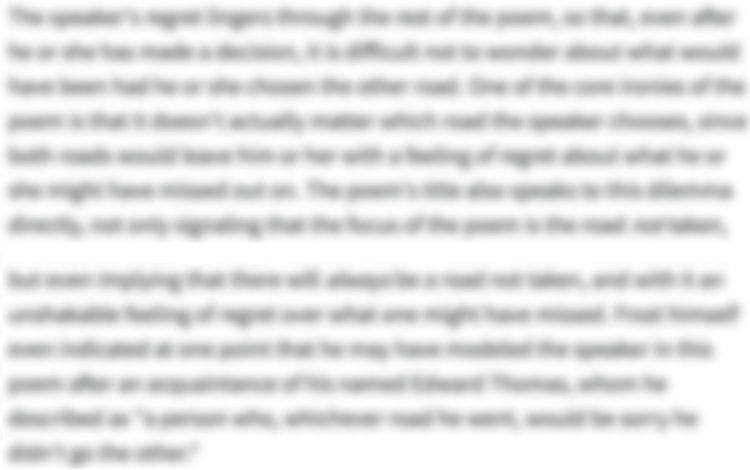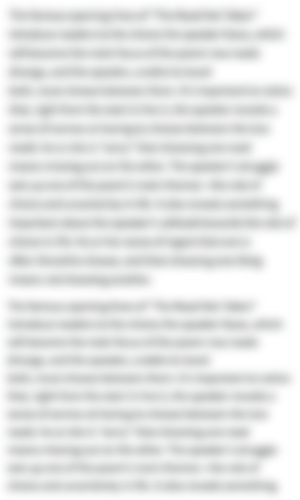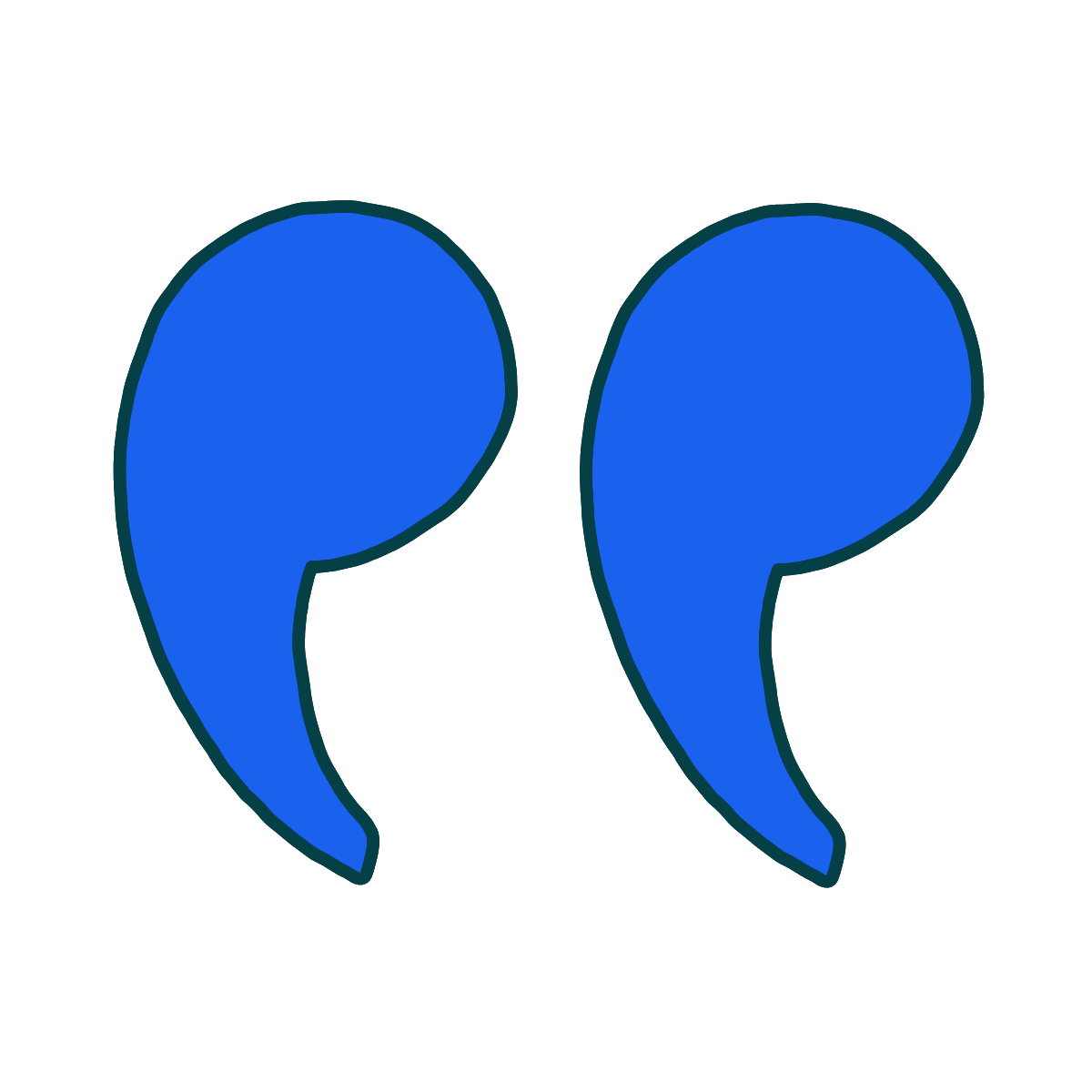The Full Text of “Huswifery”
1Make me, O Lord, thy Spining Wheele compleate.
2Thy Holy Worde my Distaff make for mee.
3Make mine Affections thy Swift Flyers neate
4And make my Soule thy holy Spoole to bee.
5My Conversation make to be thy Reele
6And reele the yarn thereon spun of thy Wheele.
7Make me thy Loome then, knit therein this Twine:
8And make thy Holy Spirit, Lord, winde quills:
9Then weave the Web thyselfe. The yarn is fine.
10Thine Ordinances make my Fulling Mills.
11Then dy the same in Heavenly Colours Choice,
12All pinkt with Varnisht Flowers of Paradise.
13Then cloath therewith mine Understanding, Will,
14Affections, Judgment, Conscience, Memory
15My Words, and Actions, that their shine may fill
16My wayes with glory and thee glorify.
17Then mine apparell shall display before yee
18That I am Cloathd in Holy robes for glory.
-
“Huswifery” Introduction
-
“Huswifery” is poem written around 1685 by the Puritan preacher Edward Taylor. The poem is addressed directly to God, making it at once a kind of plea and prayer. Through an extended metaphor in which God is a cloth maker and the speaker acts as God's cloth-making tools, the speaker offers himself up as God's humble earthly servant. By following God’s instructions and living a deeply religious life, argues the poem, people can best know and serve God.
-
-
“Huswifery” Summary
-
Dear God, make me your fully functioning spinning wheel. Make your words the rod on which the raw wool is held in place. Make my thoughts and feelings into the spinning wheel’s flyers, and my soul into its holy spool. Let my interactions with other people increase the reach of your words and bring more followers to you, like yarn winding around a reel.
Let me be your loom on which you knit this twine, and may you wind the loom's quills with your spirit. Once the delicate yarn is ready, weave it into cloth yourself. Your instructions will purify and cleanse this cloth. Then dye the cloth in the best colors of heaven, and fleck it with pink flowers of paradise.
With this cloth, cover every aspect of my mental and physical being, including all my words and actions. Doing so will make my life shine with your glory, and will also glorify you. When this happens, you will see that I am dressed in holy Robes, ready for glory.
-
-
“Huswifery” Themes
-
God and Humankind
“Huswifery,” written by the devout Puritan pastor Edward Taylor, is a deeply religious poem that reflects on humanity's relationship with God. Using an extended metaphor related to weaving cloth, the speaker implores God to help him be a good Christian. The poem feels like a kind of desperate preacher’s speech, arguing that people should give themselves entirely to God—and, only in doing so, will people receive the full extent of God’s love, glory, and majesty.
In essence the poem is a prayer asking for God’s help, while at the same time a kind of vow in which the speaker promises God his total submission, loyalty, and humility. The speaker asks to be metaphorically transformed by God into a “Spining Wheele,” the machine used to make cloth at the time of the poem’s writing. Framing the speaker's relationship to God within a household chore of the era—which was work done primarily by women—is a gesture of humility itself, showing how the speaker bows down to God’s superior greatness.
The poem then develops this metaphor by pairing different parts of the machine with different aspects of God (and the ways that people can serve God). For example, the speaker pairs God’s “Holy Worde” (that is, the Bible) with a “Distaff” (a stick that holds unspun fibers); the speaker’s religious “Affections” with “Flyers” (arms used for twisting wool); the speaker’s soul with the machine’s “Spoole”; and the speaker’s “Conversation” (Taylor was a pastor for most of his life, so this likely refers to his preaching) with the machine’s “Reele.” In each of these comparisons, God is the cloth-maker—the creator—while the speaker is simply a tool for God's work. The speaker presents obedience and total trust in God’s will as the way of best doing that work—and, in turn, of being part of God’s glory.
The second stanza develops this idea further, though now the cloth-making moves on to the next stage of the process. Whereas the first stanza was about making thread, this one is about turning that thread into cloth (so that, ultimately, it can be turned into a garment). The speaker asks God to power the loom (the machine used to make cloth) with the "Holy Spirit," and says that God’s instructions (“Ordinances”) will then cleanse the cloth (they will be the “Fulling Mills”). Again, then, God is the creator in this scenario—the one with authority and will—and the speaker is simply God's humble servant. At the same time, the intimacy of this metaphor speaks to a close relationship between humankind and God, one which requires work, dedication, and attentiveness.
This cloth will then be dyed—the next stage of the process—in the best “Heavenly Colours,” decorated with “Varnisht Flowers of Paradise.” This indicates that people will be rewarded through serving God: the world will be made beautiful (and, of course, God's followers will go to heaven).
It’s not until the final stanza that the poem reveals the full purpose behind this extended metaphor. Cloth is made, of course, for clothing. Accordingly, the speaker’s dedication and submission to God will result in a kind of spiritual warmth and comfort, what the speaker describes as “glory and glor[ification].” The speaker asks for every aspect of his life— “mine Understanding, Will, Affections, Judgment, Conscience, Memory My Words, and Actions”—to be clothed in God’s “Holy robes.” In other words, this is an argument for total dedication to religious life (not surprising, perhaps, for a Puritan pastor!). This, argues the poem, is the way to be a good Christian, and, by implication, the way to be rewarded by God.
- See where this theme is active in the poem.
-
-
Line-by-Line Explanation & Analysis of “Huswifery”
-
Lines 1-6
Make me, O Lord, thy Spining Wheele compleate.
Thy Holy Worde my Distaff make for mee.
Make mine Affections thy Swift Flyers neate
And make my Soule thy holy Spoole to bee.
My Conversation make to be thy Reele
And reele the yarn thereon spun of thy Wheele.The poem opens with a moment of apostrophe—a direct appeal to God. The speaker asks God to make him "thy Spining Wheele compleate." (Note that the unfamiliar spellings throughout the poem are just a product of the time period in which the poem was written, the 1600s.) Right away, the poem launches into its extended metaphor (which can also be thought of as the poem's conceit). A spinning wheel is a tool used to transform raw fibers into thread. Essentially, then, in asking to be God's spinning wheel, the speaker is saying that he wants to be a tool for God.
Specifically, he wants to be the machine on which God makes "Holy robes for glory." The overall implication is that a good Christian should obey the word of God, be submissive to God, and see their religion as a kind of unending daily work on behalf of God.
It’s worth noting that this chosen conceit implies that people should also be humble—the making of garments was largely the work of poor women at the time of the poem’s writing (a “huswife” is a married woman who takes care of the daily domestic chores and family affairs). The word “compleate,” meanwhile, signals that the poem is about spiritual fulfillment.
The first two words of the poem, “Make me,” alliterate. This draws attention to the force of the speaker's plea to God. It also subtly draws the reader’s attention to the construction of the poem itself—that is, the immediate use of poetic language reminds readers that this is, well, a poem, a carefully crafted piece of writing. This, in turn, mirrors the way that humankind is part of God’s creation, the way that the whole world is a kind of poem written by God. This alliteration is then repeated in lines 2, 3, and 4, reinforcing this effect.
After the first line, the rest of the stanza breaks down the various parts of the spinning wheel. A “Distaff” holds raw wool or flax in place. The speaker links this to God’s “Holy Worde”—an allusion to the Bible. Essentially, the speaker is promising to use the Bible as a way of regulating and guiding his life, of holding his life in place just as the "Distaff" holds the raw materials for the spinning wheel in place.
Similarly, the speaker asks for his “affections” to be the machine’s “Flyers” and his “Soul [God’s] holy Spoole.” These are again references to various mechanical parts of the spinning wheel. Consonance through /f/ sounds tie the first pair together ("affections" and "Flyers"), while alliterating /s/ sounds make a pair of the latter ("Soul" and "Spoole"). These shared sounds convey the speaker’s desire to have a deep and strong bond with God, with God as a metaphorical weaver and the speaker as God's machinery.
The stanza’s closing couplet likens the speaker’s “Conversation” to God’s “Reele.” A reel is a small device around which yarn or thread is wound; the word can also be used as a verb in reference to turning that reel, or more generally in reference to winding something up or drawing something in (think of the phrase "to reel a fish"). The speaker wants to be that reel and also to reel on behalf of God. The use of "reele" in lines 5 and 6 is thus an example of the poetic device antanaclasis.
This part of the metaphor relates to Taylor’s role in Puritan society. As a pastor, Taylor was tasked with advising and giving counsel to his community—and, accordingly, he wishes in this poem for his social interactions to be an accurate and strong interpretation of God’s will. He wants to bring other people into God's service, to reel them in.
-
Lines 7-9
Make me thy Loome then, knit therein this Twine:
And make thy Holy Spirit, Lord, winde quills:
Then weave the Web thyselfe. The yarn is fine.

Unlock all 315 words of this analysis of Lines 7-9 of “Huswifery,” and get the Line-by-Line Analysis for every poem we cover.
Plus so much more...
Get LitCharts A+ -
Lines 10-12
Thine Ordinances make my Fulling Mills.
Then dy the same in Heavenly Colours Choice,
All pinkt with Varnisht Flowers of Paradise. -
Lines 13-16
Then cloath therewith mine Understanding, Will,
Affections, Judgment, Conscience, Memory
My Words, and Actions, that their shine may fill
My wayes with glory and thee glorify. -
Lines 17-18
Then mine apparell shall display before yee
That I am Cloathd in Holy robes for glory.
-
-
“Huswifery” Poetic Devices & Figurative Language
-
Alliteration
Alliteration is used prominently throughout "Huswifery." For example, it pops in a recurring phrase throughout the first two stanzas: "Make me"/"Make mine." The shared /m/ sounds here draw readers' attention to these words, adding emphasis to the speaker's plea to God. Later, in line 4, alliteration is used to underscore the connection between the speaker and God: the speaker wants his "Soule" to be God's "holy Spoole." There's also quite a bit of alliteration on the /th/ sound throughout the poem, though much of this is just a byproduct of the time period in which the poem was written, when words like "thy" and "thine" were common.
A more evocative example is found in lines 8 to 9:
And make thy Holy Spirit, Lord, winde quills:
Then weave the Web thyselfe. The yarn is fine.The /w/ sound here affirms God's creative power. It connects God's agency—God's ability to "winde" and "weave"—to parts of a part of the metaphorical loom as well as to the products of that loom. The speaker wants to be both a tool for God and part of the raw materials that God uses to create—but only God can "winde" the loom's "quills" (note that "qu" creates a /w/ sound when read out loud), and only God can "weave the Web."
- See where this poetic device appears in the poem.
-
Apostrophe


Unlock all 219 words of this analysis of Apostrophe in “Huswifery,” and get the poetic device analyses for every poem we cover.
Plus so much more...
Get LitCharts A+ -
Allusion
-
Assonance
-
Caesura
-
Consonance
-
Extended Metaphor
-
-
“Huswifery” Vocabulary
Select any word below to get its definition in the context of the poem. The words are listed in the order in which they appear in the poem.
- Thy / Thyselfe
- Spining Wheele
- Compleate
- Distaff
- Mine
- Swift Flyers
- Spool
- Reele
- Yarn
- Thereon / Therein
- Loome
- Twine
- Holy Spirit
- Winde Quills
- Thine
- Ordinances
- Fulling Mills
- Pinkt
- Varnisht
- Therewith
- Apparell
Thy / Thyselfe-
An archaic form of "you." "Thyselfe," accordingly, means "yourself."
- See where this vocabulary word appears in the poem.
-
Form, Meter, & Rhyme Scheme of “Huswifery”
-
Form
“Huswifery” is made up of three stanzas with six lines apiece. The first four lines of each stanza follow an ABAB rhyme scheme, while the final two lines of each stanza form rhyming couplets.
The poem is one long extended metaphor related to the relationship between people and God (an important subject for Taylor, who was a Puritan minister). Essentially, the three stanzas divide into three key stages in this metaphor. The first deals with the way raw wool is turned into thread, conveying the way that people should (in the speaker’s opinion) treat life as a kind of raw material ready to be transformed in the service of God.
The second stanza takes this metaphorical thread and weaves it into cloth, deepening the metaphorical connection between humankind and God (or, more specifically, between the speaker and God). This cloth should then be made beautiful by God, characterized by heavenly colors and flowery decoration. In the final stanza, the poem makes the purpose of the metaphor clear. The speaker wants to be clothed in God’s cloth, to serve God and express God's will in everyday life. Achieving this will bring glory to the speaker, and in turn glorify God too.
-
Meter
“Huswifery” is written in iambic pentameter. This means that most lines consist of five poetic feet, with each foot made of an unstressed syllable followed by a stress (da-DUM). The sound of this meter is important to the poem. It lends the words an air of authority, the controlled pattern of the stresses conveying God’s control of the metaphorical cloth-making process. The iambs also convey the alternating process required for the weaving of fabric, which involves repeatedly layering one thread over another. The poem alternates between a stressed and then a stressed syllable, mimicking this process.
A typical example of this pattern can be found in the very first line:
Make me, | O Lord, | thy Spin- | ing Wheele | compleate
Of course, the initial foot here can be read as a regular iamb, placing the emphasis on "me," or as a spondee (as we've done here), meaning both "Make" and "me" are stressed; this latter reading emphasizes the urgency of the speaker's request, while the former suggests how ready the speaker is himself to do God's bidding.
There are a handful of other moments in which the poem varies its steady iambic pattern. Line 3, for example, places two unstressed syllables side-by-side before then compensating with two stresses. This quickens the line, echoing the “swift[ness]” of God’s metaphorical “Flyers”:
Make mine | Affec- | tions thy | Swift Fly- |ers neate
The last two lines also offer up some important variation. Both lines add an extra unstressed syllable at the end of the line:
Then mine | appa- | rell shall | display | before | yee
That I | am Cloathd | in Ho- | ly robes | for glo- | ry.These two extra syllables are like the poem’s final flourish, functioning like a decorative element added to clothing just for aesthetic beauty.
-
Rhyme Scheme
“Huswifery” has a tight-knit rhyme scheme that matches with a number of Taylor’s other poems. Each stanza runs:
ABABCC
As this poem is all about the creation of fabric (as a metaphor for how to live a properly religious life), a well-structured rhyme scheme makes sense. This foregrounds the poem’s own construction as a kind of object made out of text, which in turn helps bring the poem’s metaphor to life. In other words, the poem itself didn't just appear out of thin air, but rather it was created—just as God creates using the spinning wheel and cloth—and its careful rhyme scheme underscores its "poetic," or created, nature.
To that end, the rhymes are almost perfect throughout: compleate/neate, me/be, will/fill etc.; the only two slant rhymes are Choice/Paradise in lines 11 and 12 and Memory/glorify in lines 14 and 16. Overall, the steadiness of the poem's rhymes embodies a kind of perfection, the pleasant ringing-out of the rhyme words conveying God’s skill and command of beauty.
-
-
“Huswifery” Speaker
-
The speaker of “Huswifery” is someone trying to talk directly to God through apostrophe. No specifics are offered about who this speaker is, but it’s clear that this person longs for a close and fulfilling relationship with God. Given that Taylor was a Puritan minister, his poetry is generally taken to reflect his own thoughts about this relationship between human beings and God. Indeed, the Calvinist beliefs that informed the Puritan movement argue for a close personal relationship between individuals and God (as opposed to the Catholic approach which emphasized intermediaries such as the Pope). Accordingly, it makes sense that the reader is a kind of intruder here—this is an intimate poem that portrays the speaker’s deepest thoughts, feelings, beliefs, and wishes about religion.
Because the poem is so closely associated with Taylor's own beliefs, we've chosen to use masculine pronouns throughout this guide. Do note that it's entirely possible to read the poem as being from a woman's perspective.
-
-
“Huswifery” Setting
-
Because “Huswifery” consists of an extended metaphor, it doesn’t really have a particular setting. That is, the poem is figurative rather than literal. Ultimately, the poem is set in the speaker’s mind, offering the speaker's take on the relationship between humankind and God. Like a prayer, the poem can also be thought of existing in the space between an individual and God. The poem is an attempt to bridge that divide and to communicate with God in order to offer loyalty and ask for a certain kind of spiritual help and nourishment.
The extended metaphor itself, though, is grounded in the daily reality of 17th century Puritan life. “Huswifery”—housewifery—is a world of daily repetitive chores, such as the one discussed in the poem: the making of cloth/garments.
-
-
Literary and Historical Context of “Huswifery”
Literary Context
Edward Taylor was Puritan minister and poet who lived from 1642 to 1729. He was born in England around the time of the English Civil War, and may have been employed in the local weaving trade as a young man (which might partly explain the detailed knowledge of cloth-making on display in this poem). He grew up on a farm in Leicestershire and like his father was a Protestant dissenter (people who refused to ally themselves to the official Church of England). Taylor was working as a teacher in 1662 when he refused to sign the Act of Uniformity, a piece of legislation which dictated the prayers, sacraments, and rites for the English to use in their religious practice. Taylor subsequently emigrated to America where, after studying at Harvard, he became a Puritan minister in Westfield, Massachusetts, a role he maintained for nearly 60 years.
It was during this time that Taylor wrote most of his poetry (as well his religious services). Taylor was highly disciplined with his writing, composing 217 “Meditations” each Saturday for 43 years (Saturday being the Eve of the Lord’s Supper). His poems were explorations and expressions of his deeply held religious beliefs, reflecting the Calvinist idea that spiritual salvation requires a close personal relationship between individuals and God.
Critics have noted the similarity of Taylor’s output to the English Metaphysical poets of the Elizabethan era. As displayed in this poem, Taylor’s writing shares a commitment to inventive and extended metaphor (also known as conceit) with poets like John Donne, Andrew Marvell, and George Herbert. Donne's Holy Sonnets in particular (including "Death, be not proud" and "Batter My Heart, Three-Person'd God") make for interesting comparison, also addressed directly from the speaker to his God.
Historical Context
Taylor’s life story takes place on either side of the Atlantic Ocean. During his lifetime, both England and the American settlements were deeply religious environments. Religion in England was a divisive subject during the 16th and 17th century, to say the least. The Puritan movement took exception to certain elements of the official Church of England, believing it to require further reform away from its Catholic roots. Some Puritans advocated for separating from the official Church, while others wanted to stay within its institution.
In 1620, a number of separatists travelled from England to New England, U.S.A. Known as Pilgrims, they sailed on the famous Mayflower and are an important part of the (white) American origin story and folklore. Around a hundred passengers undertook the arduous crossing over the Atlantic, with around half of them surviving to establish a colony in Plymouth, Massachusetts. Taylor himself moved to Massachusetts in 1668.
The poem's subject matter (and title) relate to a form of labor mostly undertaken by women. This is probably an attempt to lend the poem an air of humility. Well before the era of mass manufacture of clothes, spinning and weaving were a regular chore, part of the fabric of the daily existence of a housewife.
-
More “Huswifery” Resources
-
External Resources
-
Edward Taylor's Life and Work — A valuable resource on Taylor's biography and output from the Poetry Foundation.
-
Edward Taylor's Sermons — A collection of Taylor's religious sermons.
-
A Lecture on Taylor — Interesting thoughts on Edward Taylor's output from a university lecturer.
-
Puritan Poetry — Poems by other writers from the same era.
-
Taylor's Place — An article about Taylor's place in American (and English) poetry.
-
-









